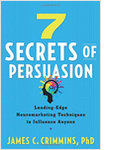 | To understand the art of persuasion, you can turn to cognitive science for guidance in dealing with the unconscious “lizard” mind. Advertising strategist James C. Crimmins investigates the cognitive science behind motivation to show you how to persuade others more effectively. The “automatic” part of the human mind – the lizard brain – affects many decisions. To persuade the lizard to cooperate, learn its language. To be persuasive, help it fulfill its desires. Crimmins explains how to unearth the lizard’s drives and change its expectations so they match the consumer’s experience of your message. Note that the way you convey a message may matter more than the message itself. getAbstract recommends this fascinating overview to marketing professionals and anyone seeking insight into how people think and what motivates them to act. In this summary, you will learn:
Request Free! |
